Human Orbital Spaceflights
![]()
International Flight No. 105STS-51FChallenger (8)19th Space Shuttle missionUSA |
 |
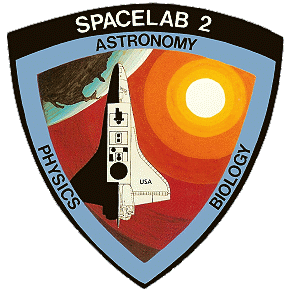 |
![]()
Launch, orbit and landing data
walkout photo |
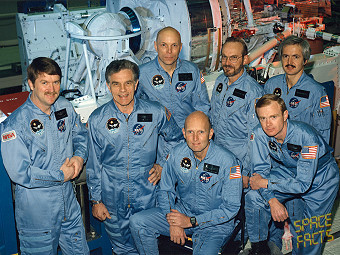 |
||||||||||||||||||||||||||||
alternative crew photo |
Crew
| No. | Surname | Given names | Position | Flight No. | Duration | Orbits | |
| 1 | Fullerton | Charles Gordon | CDR | 2 | 7d 22h 45m 26s | 127 | |
| 2 | Bridges | Roy Dubard, Jr. | PLT | 1 | 7d 22h 45m 26s | 127 | |
| 3 | Henize | Karl Gordon | MS-1, RMS | 1 | 7d 22h 45m 26s | 127 | |
| 4 | Musgrave | Franklin Story | MS-2, EV-1, FE | 2 | 7d 22h 45m 26s | 127 | |
| 5 | England | Anthony Wayne | MS-3, EV-2, RMS | 1 | 7d 22h 45m 26s | 127 | |
| 6 | Acton | Loren Wilber | PS-1 | 1 | 7d 22h 45m 26s | 127 | |
| 7 | Bartoe | John-David Francis | PS-2 | 1 | 7d 22h 45m 26s | 127 |
Crew seating arrangement
|
 |
|
||||||||||||||||||||||||||||||||
Backup Crew
|
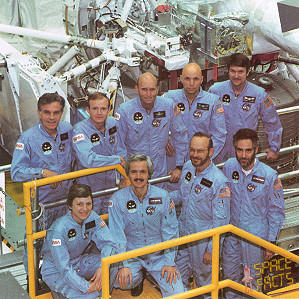 |
Hardware
| Orbiter : | OV-099 (8.) |
| SSME (1 / 2 / 3): | 2023 (3.) / 2020 (4.) / 2021 (4.) |
| SRB: | BI-017 |
| ET: | ET-19 (LWT-12) |
| OMS Pod: | Left Pod 01 (7.) / Right Pod 04 (2.) |
| FWD RCS Pod: | FRC 9 (8.) |
| RMS: | 302 (3.) |
| EMU: | EMU No. 1064 (PLSS No. 1010) / EMU No. 1065 (PLSS No. 1007) |
Flight
|
Launch from Cape Canaveral (KSC) and
landing on the Edwards
AFB, Runway 23.
The countdown for a planned launch on July 12, 1985 had been halted at T-3 seconds after main engine ignition when a malfunction of number two Space Shuttle Main Engine (SSME) coolant valve caused shutdown of all three main engines. Following STS-41D it was the second time in the Shuttle program that the Main Engines were shutdown. The launch took place at July 29, 1985 after a delay of one hour, 37 minutes due to a problem with the table maintenance block update uplink. Three minutes and 31 seconds into the ascent, one of the center engine's two high pressure fuel turbopump turbine discharge temperature sensors failed. Two minutes and 12 seconds later, the second sensor failed, causing the shutdown of the center engine. This was the only in-flight main engine failure of the shuttle program. Approximately 8 minutes into the flight, one of the same temperature sensors in the right engine failed, and the remaining right engine temperature sensor displayed readings near the redline for engine shutdown. Booster Systems Engineer Jenny M. Howard acted quickly to command the crew to inhibit any further automatic SSME shutdowns based on readings from the remaining sensors, preventing the potential shutdown of a second engine and a possible abort mode that may have resulted in the loss of the vehicle and crew. The failed SSME resulted in an Abort to Orbit (ATO) trajectory, whereby the shuttle achieved a lower-than-planned orbital altitude. This was the only ATO in 135 Space Shuttle missions. Shuttle launch abort philosophy aims toward safe and intact recovery of the flight crew, the orbiter and the payloads. In descending order of desirability, abort modes are as follows: - Abort-to-orbit (ATO) - partial loss of main engine thrust late enough to permit reaching a minimal 194-km (105-nm) orbit with orbital maneuvering system engines. - Abort-once-around (AOA) - earlier main engine shutdown, but near enough orbital speed to allow one orbit around to the Shuttle Landing Facility at Kennedy Space Center. - Trans-Atlantic abort landing (TAL) - loss of two main engines midway through powered flight, forcing a landing at an airport in Europe or Africa. - Return to launch site (RTLS) - early shutdown of one or more engines and without enough energy to make Dakar; pitch-around and thrust back toward Kennedy Space Center until within gliding distance of Shuttle runway. Contingency landing sites were Kennedy; Edwards Air Force Base, Calif.; White Sands Missile Range, N.M.; Hickam Air Force Base/Honolulu International, Hawaii; Kadena Air Force Base, Okinawa. STS-51F carried the third flight of Spacelab (Mission SL-2). A special part of the modular Spacelab system, the "igloo", which was located at head of a three-pallet train, provided on-site support to instruments mounted on pallets. The main mission objective was to verify performance of Spacelab systems, determine the interface capability of the orbiter, and measure the environment created by the spacecraft. Experiments covered life sciences, plasma physics, astronomy, high-energy astrophysics, solar physics, atmospheric physics and technology research. Despite mission replanning necessitated by Challenger's abort to orbit trajectory, the Spacelab mission was declared a success. This pallet-only configuration consisted of unpressurized platforms (pallets) in the payload bay which, with the pointing system, turn Spacelab into a unique orbiting observatory for studying the sun, stars and space environment. An igloo, a cylindrical shell attached to the first pallet, houses many of the systems such as computers and data recorders. These systems previously have been located inside a pressurized laboratory module element flown on the two earlier dedicated Spacelab missions, but the module is not required for this flight. Thirteen experiment teams, 11 from the United States and two from the United Kingdom, were directing investigations in solar physics, atmospheric physics, plasma physics, infrared astronomy, high energy astrophysics, technology research and life sciences. Ten of these experiments require direct exposure to space and were mounted on the pallets and in a special support structure inside the payload bay. One experiment conducted from the ground used the Shuttle as a research tool. Two life sciences experiments were located in middeck lockers. Another new Spacelab component, the ESA-developed Instrument Pointing System, was being tested during its inaugural flight. On the first pallet, three solar instruments and one atmospheric instrument are attached to the pointing system, which can aim them more accurately than the Shuttle alone and keep them fixed on targets as the Shuttle moves. The pointing system had a relative accuracy of 2 arc seconds (one eighteen hundredth of a degree), which means it could remain pointed in stable fashion at an object the size of a quarter from a distance of less than one and a half nautical miles (900 meters). The Instrument Pointing System (IPS) was a versatile pointing system for use on the orbiter to provide precision orientation capability to a scientific experiment requiring essentially better pointing accuracy and stability than that provided by the orbiter. The IPS was thermally controlled by application of an active heating system on the critical components and a combination of insulated and radiating areas to control the heat exchange to its environment during all critical hot and cold operations. During launch and landing phases the payload will be supported by three attachment flanges with the payload clamp assembly. For on-orbit stowage the payload attachment flanges were shifted by the payload gimbal separation mechanism on the equipment platform into three payload clamp units. Some problems were experienced when it was commanded to track the Sun, but a series of software fixes were made and the problem was corrected. The IPS was developed by Dornier Corporation in Germany. This mission also used a different method for commanding and monitoring Spacelab instruments. On two previous missions, Spacelab 1 (STS-9) and 3 (STS-51B), the payload crew operated instruments from inside the habitable module. This payload crew worked inside the orbiter aft flight deck, located directly behind the cockpit. Equipment, such as the Spacelab computer consoles, television monitors, controls for the Instrument Pointing System, data collection and various experiments are mounted along panels in the U-shaped work area. Three of the mission's experiments made solar observations in visible and ultraviolet light. Above the atmosphere, the instruments see solar emissions that are undetectable from the ground. Mounted together on the Instrument Pointing System, these instruments provide data to make a composite image of the sun's magnetic, structural and gaseous elements. During the mission, the crew and ground investigators are able to select areas of solar activity as viewing targets. The atmospheric physics experiment, closely related to the Spacelab 2 solar investigations, measured solar ultraviolet radiation in the upper atmosphere. The instrument was scheduled to fly on several Spacelab missions so that long-term variations in solar ultraviolet radiation can be identified. The three Spacelab 2 plasma physics experiments investigated processes in the ionosphere, the upper atmospheric region in which the Shuttle-Spacelab travels. The ionosphere is affected by the electrified gas or plasma that streams continuously from the sun. This mission's investigations study the plasma environment with a free-flying satellite filled with sensors, by artificially stimulating the plasma with electrons and with ground observatories that can monitor the spacecraft's effect on the atmosphere. High energy radiation, in the forms of X-Ray and gamma-ray radiation and charged particles called cosmic rays, cannot be observed from Earth. Above the atmosphere, Spacelab 2 carried two large, sensitive high-energy radiation detectors. Spacelab 2, with its delicate observational instruments, provided a chance to test advanced cooling systems. Extremely low temperatures allow telescopes to detect celestial radiation without the interference of background emissions from the instruments themselves. The two Spacelab 2 life science investigations examined human and plant biological processes in the space environment. One investigation studies biochemical agents in human blood during space flight. The other was a variation of a plant growth experiment previously flown on the third Shuttle mission. The experiment, Protein Crystal Growth in a Microgravity Environment, was sent into orbit during Shuttle Mission STS-51D. During the STS-51F flight, it again used the stability of low gravity to produce more nearly perfect crystals in space. Scientists have predicted that these crystals can be grown many times larger in space. When grown on Earth, these crystals are so small that scientists cannot analyze the molecular structure of the crystals. On this test flight, the experiment operates automatically with limited crew intervention. The American Radio Relay League (ARRL) and Radio Amateur Satellite Corp. (AMSAT) began a Shuttle Amateur Radio Experiment (SAREX) this mission with "ham" radio and TV operators on Earth. The radio and TV experiment were sponsored by NASA. Two of NASA's onboard astronaut amateur radio operators, Anthony England, mission specialist, and John-David Bartoe, payload specialist, conversed from Challenger with hams through a handheld radio. Gordon Fullerton, spacecraft commander, was a former amateur radio operator and also may take the microphone. One part of the SAREX experiment was to involve youth interested in science and technology in the Space Shuttle Program. Rather than spend the limited SAREX time talking randomly to amateurs on the ground, astronauts will talk to clubs with dedicated frequencies for 1 or 2 minutes. First operation of a ham radio from space was by astronaut Owen Garriott through a portable 2-m transceiver from Columbia on STS-9. Ejectable Plasma Diagnostics Package (PDP): The instrument package, flown previously on the third Shuttle mission (STS-3), was extended and released by the Remote Manipulator System (RMS) to make measurements after the orbiter has maneuvered to selected attitudes. On the third flight day after about seven hours of operation as a free-flyer, the PDP was recaptured by the manipulator arm and returned to the vicinity of the payload bay. Before landing, it was locked back in place on the aft pallet. The Plasma Diagnostics Package was a comprehensive assembly of electromagnetic and particle sensors that was used to study the interaction of the orbiter with its surrounding environment; to test the capabilities of the Shuttle's Remote Manipulator System. In support of those objectives, the package took measurements of electric and magnetic fields within 13.7 m (45 ft.) of the orbiter; ion and electron densities, energies and spatial distribution; electromagnetic waves over a broad frequency range; and determine the characteristics of the electron beam emitted by the Fast Pulse Electron Generator provided by Utah State University and measure the resulting beam-plasma interactions in terms of fields, waves and particle distribution. The Spacelab Infrared Telescope (IRT) was also flown on the mission. The IRT was a 15.2 cm aperture helium-cooled infrared telescope, observing light between wavelengths of 1.7 to 118 µm. The experiment experienced some problems, such as heat emissions from the Shuttle corrupting data, but still returned useful astronomical data. In a heavily-publicized marketing experiment, astronauts aboard STS-51F drank carbonated beverages from specially-designed cans provided by competitors Coca-Cola and Pepsi. Post-flight, the astronauts revealed that they preferred Tang, in part because it could be mixed on-orbit with existing chilled water supplies, whereas there was no dedicated refrigeration equipment on board to chill the soda, which also fizzed excessively in microgravity. |
Photos / Graphics
 |
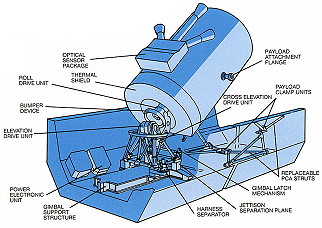 |
 |
 |
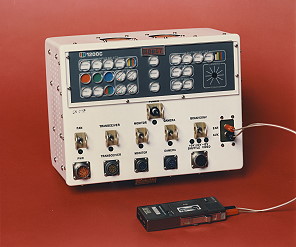 |
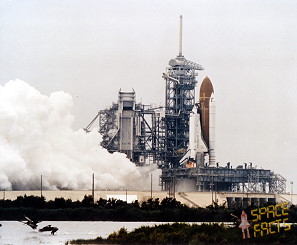 |
 |
 |
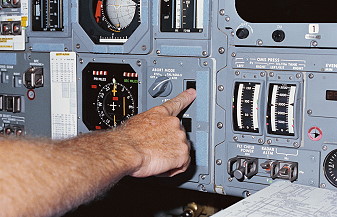 |
 |
 |
 |
 |
 |
 |
 |
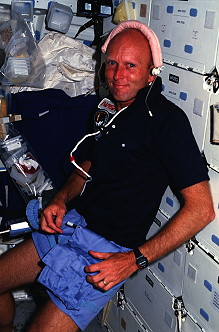 |
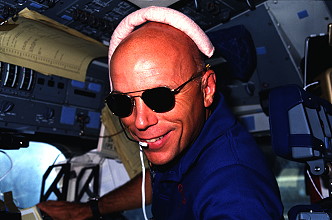 |
 |
 |
more Earth observation photos |
|
| © |  |
Last update on June 23, 2023.  |
 |